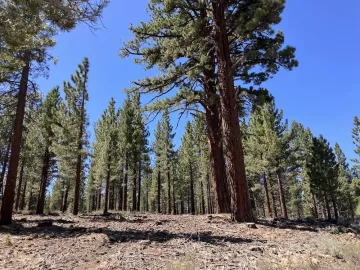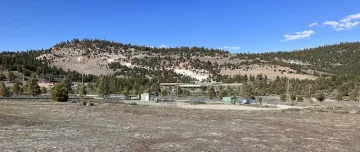Link to a presentation on biomass by Maya Khosla hosted by the Range of Light Group (passcode: yLO$&1cF)
Forest Thinning Pros and Cons
Removing trees from a forest significantly reduces carbon sequestration. It is not carbon neutral until the trees grow back or trees grow thicker and start absorbing carbon--a delay of 300 years into the future to regain the same sequestration capacity.
- The "donut" project (aka Eastern Sierra Climate and Communities Resilience Project [ESCCRP]) has been approved and will remove thousands of trees. It will reduce the carbon sequestration of the forest.
- Trees grow back so there will be carbon sequestration, but not equivalent to the loss.
- Thinning with heavy equipment disturbs the soil and immediately releases carbon into the atmosphere.
- More carbon is removed by "thinning" than is lost when trees are killed by wildfires.
Thinning the forest to get it to an uneven aged forest will help save the forest and prevent more carbon going into the atmosphere from the wildfire and not further reduce the carbon sequestration capacity. If done right, thinning can be an effective tool, i.e., removing small diameter trees, not big ones, leaving snags and down logs, not clearcutting in patches.

- Removing dead trees from bark beetle die-offs is unnecessary. Dead trees don't make forest fires worse. Wind does.
Logging after a wildfire is not good for the forest and releases all of the carbon of the forest into the atmosphere.
- Forest fires don't burn trees through and through, but burning for biomass does.
- Less of bigger trees are burned in a wildfires than smaller trees. Frequently, only the bark is burned off the bigger trees.
- Trees that are left in the forest after a forest fire decompose slowly and release carbon slowly.
- Clear cutting brings in more invasive grasses that shorten the wildfire interval.
- Lots of wildlife use burned forests: woodpeckers, flickers, bluebirds, wood peewee, foxes, martens, fishers, ringtail cats, bobcats. Burned forests are natural ecosystems.
Managing the Forest in the Eastern Sierra
In the Eastern Sierra, we have patches of even-aged forests where it was logged, which is a wildfire hazard. It was a timber forest and logged until the 1980s(?), so all the trees are the same size and the same age. Thinning to convert the forest to an uneven-aged forest will make them more resilient to forest fires, especially if traditional burning is done periodically.
- Traditional or controlled burning isn't always necessary if the forest is uneven aged.
- Forest thinning done badly increases the likelihood of a wildfire wiping out a forest.
- A wildfire burns more low to the ground and less hot in a forest that has been thinned (and control-burned?).
Forest management changed in the Eastern Sierra from timber production to recreation. Forests were left as even-aged forests. So, in the 1980s thinning was done for the next 20 years (as much as the budget would allow) to create healthier, uneven-aged forests. Then thinning stopped for 20 years or so and has started up again in recent years. Forests thinned 30-40 years ago are more diverse and resilient as they promoted uneven-aged forests.
Biomass Facilities Pros and Cons
Biomass facilities emit pollutants that cause cancer within a 3-mile radius in the surrounding area before the smoke is dispersed or blown away. In the Eastern Sierra, we have air pollution controls (because of the dust controls on Mono and Owens Lakes) that won't allow for any pollutants to come from a biomass facility.

- The biomass plant here would have zero-emission scrubbers.
- There are fires in biomass facilities where chippings self-combust that would not be scrubbed.
- Controlled burns, traditional burns, slash pile burns would put pollutants in the air.
- Green wood puts more pollutants in the air than dry wood.
- Facilities that produce wood pellets mix in things that create more toxic air pollution.
They say that the Eastern Sierra is unique in that the wood from the trees isn't lumber grade and hauling logs to market (to Reno? to Sacramento?) would contribute to air pollution and putting CO2 into the atmosphere.
- Biomass energy generation can make use of the logs and slash from thinning.
- They say the donut project won't happen if there isn't a way to dispose of the logs and slash.
Burning the trees that are removed immediately releases carbon even if the emissions are scrubbed. There is carbon on the scrubbers that needs to be disposed of (buried?), even if it doesn't go into the atmosphere.
Fuel stock for a biomass plant will come from trees thinned for the "donut" project. When those are all burned, the plant would not be torn down or mothballed. The trees in the forest will keep growing and getting thicker and will need continual thinning. That would feed the biomass plant sustainably (?) so there wouldn't be a need for burning trash and turning the plant into an incinerator.
Saving the Town of Mammoth Lakes
To save the town of Mammoth from burning down, home hardening is the most effective thing that can be done. A cleared area, aka a defensible space around each home is necessary. Maya shared a story about a house in the forest that had a defensible space that was spared destruction when a forest fire jumped right around it because of lack fuel immediately adjascent to the home.
Thinning the forest saves the forest, not the town.
Doing it Right
• Thinning done poorly is a disaster. Thinning done right can protect a forest
• The donut project and the biomass facility could be a model for the state on how to best protect a forest and a town.
By Lynn Boulton